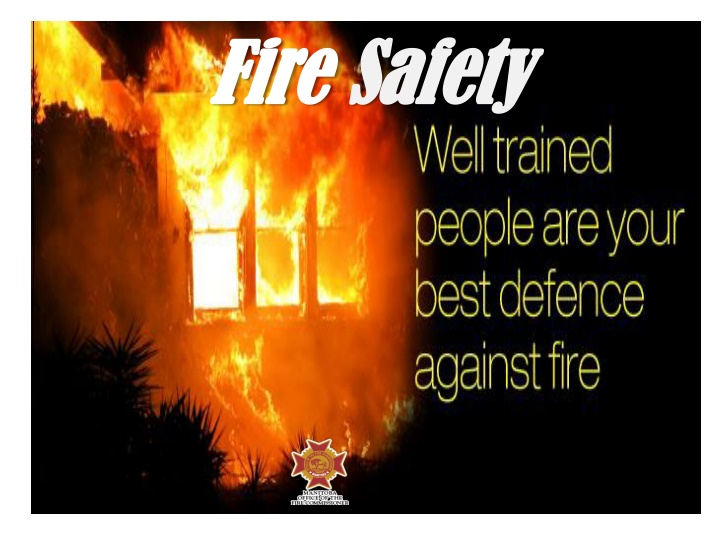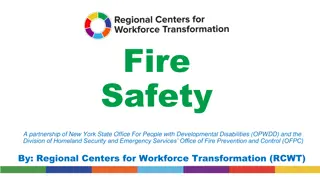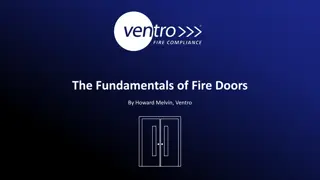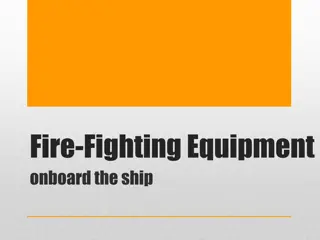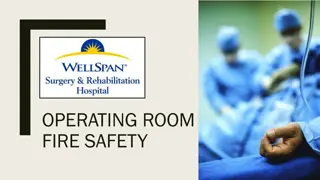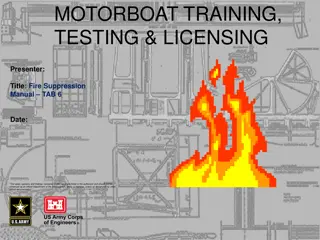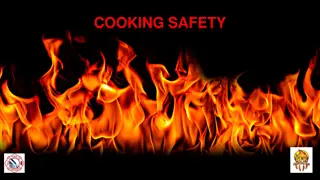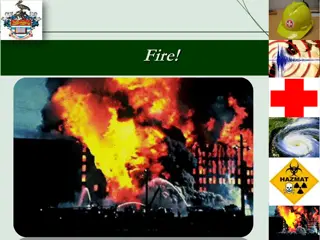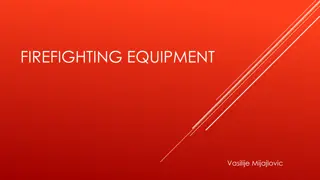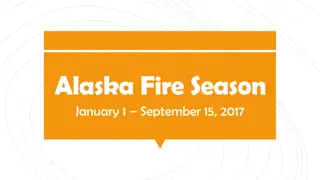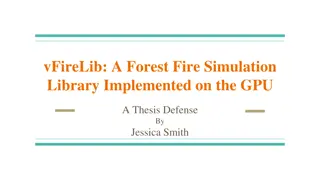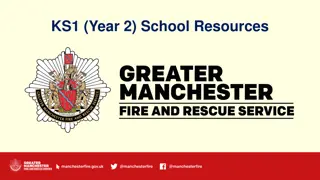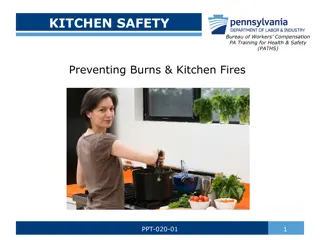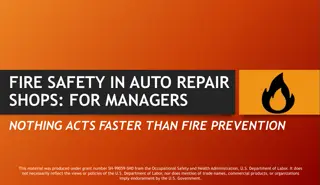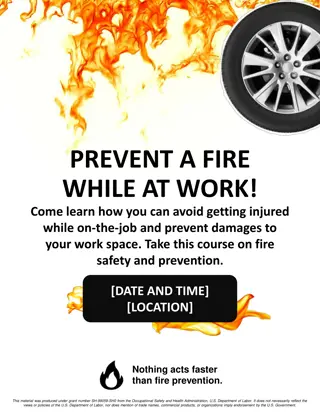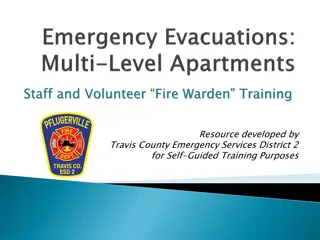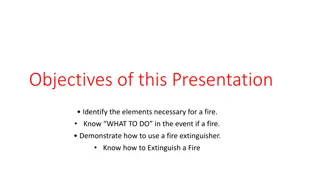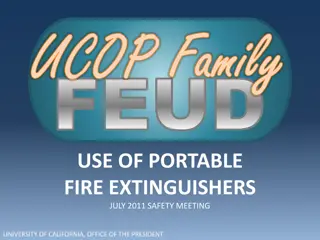Importance of Fire Safety Education in Preventing Home Fires
Attitudes and education play a crucial role in shaping people's perceptions of fire safety. Many individuals overlook the importance of fire safety, assuming it won't happen to them. However, the reality is that fires can occur quickly, especially with modern home construction materials. This emphasizes the need for a proactive approach towards fire safety, including the installation of smoke alarms, understanding fire risks in the kitchen, and educating oneself and family members on fire prevention measures.
Download Presentation

Please find below an Image/Link to download the presentation.
The content on the website is provided AS IS for your information and personal use only. It may not be sold, licensed, or shared on other websites without obtaining consent from the author.If you encounter any issues during the download, it is possible that the publisher has removed the file from their server.
You are allowed to download the files provided on this website for personal or commercial use, subject to the condition that they are used lawfully. All files are the property of their respective owners.
The content on the website is provided AS IS for your information and personal use only. It may not be sold, licensed, or shared on other websites without obtaining consent from the author.
E N D
Presentation Transcript
http://www.afs-firewise.co.uk/images/image3.jpg Fire Fire Safety Safety
Attitudes and Education shape the way most Canadians think about Fire Safety. You could even say many people don t think about it at all. https://encrypted-tbn1.gstatic.com/images?q=tbn:ANd9GcROpq0MNzs3-9HH4Azx1eDT3uhjXWma8xs_lnlV9YABkbmSDh1j ATTITUDE: It will never happen to me. Community Safety is not my responsibility. I have time to get out. EDUCATION: Many don t understand fire realities. Fire safe behaviours have not been learned and put into practice. http://www.ehs.columbia.edu/Images/FireSafety1.jpg
What does this mean to you? NOT ONLY CAN IT HAPPEN BUT IT CAN HAPPEN VERYFAST!!!!! Homes and materials are NOT built/made the way they used to be. Changing Attitudes and Educating yourself and your family can save lives. There s NO TIME to waste in getting FIRE SAFE! Let s look at how we can STOP a fire from happening to begin with. http://www.ehs.columbia.edu/Images/FireSafety1.jpg
http://chicagoareafire.com/blog/wp-content/uploads/2012/10/Woodstock_212.jpghttp://chicagoareafire.com/blog/wp-content/uploads/2012/10/Woodstock_212.jpg Smoke Alarms FACT: Most fatal home fires happen at night. The smell of smoke may not wake you. Fires produce smoke and poisonous gas. Often this is the cause of death NOT burning. A smoke alarm is an early warning that can give you the minutes you need to escape. REMEMBER you may ONLY have a couple of minutes. Having WORKING smoke alarms reduces your risk of dying in HALF! http://www.ehs.columbia.edu/Images/FireSafety1.jpg
Where should they go? Smoke alarms should be placed on each level of your home. Outside all sleeping areas. For added protection, in the bedrooms. Especially for children. Check the battery once a month and replace the battery at least once a year. Replace your smoke alarm every 10 years. http://www.ehs.columbia.edu/Images/FireSafety1.jpg
Cooking Safety Cooking is the #1 cause of Home Fires in Canada! Can you spot some Kitchen Hazards?
Kitchen Safety Tips..... 1. Keep pot handles turned in. 2. Clear the clutter. 3. Keep cords neatly wrapped. 4. One appliance in an outlet. Unplug when not in use. 5. NEVER LEAVE! Look while you COOK! Oil and fat can ignite. 6. Wear fitted clothing OR roll up your sleeves. 7. If a pot catches fire, carefully cover it with a lid and turn off the stove. 8. The kitchen is not a playground. Kids need to stay a safe distance away. 9. If it can burn keep it AWAY from the stovetop. http://www.smh.com.au/ffximage/2008/02/26/LHdinner_wideweb__430x429,0.jpg Don t let this be your home.
Fire Extinguishers http://www.protechfire.org/wp-content/uploads/2008/08/pass-fire-extinguisher.jpg A portable fire extinguisher can be an effective tool in saving lives and property. Keep one near the kitchen and KNOW when to use it and how to use it. http://www.ehs.columbia.edu/Images/FireSafety1.jpg
Heating http://completeelectrical.biz/wp-content/uploads/2013/12/Space-heater-servicemaster-tips.jpg Keep anything that can burn at least 1 meter (3 feet) from a heat source. Never use your oven to heat your home. Turn heaters off when not in use. http://www.ehs.columbia.edu/Images/FireSafety1.jpg
Smoking Never smoke in bed or when you are sleepy. http://www.triblocal.com/plainfield/files/cache/2012/02/SmokingWebAd4.jpg/460_345_resize.jpg Use a deep, sturdy ashtray. Smoke outside. Never leave matches and lighters in sight of children. Teach children to tell you if they find matches or lighters. http://www.ehs.columbia.edu/Images/FireSafety1.jpg
Housekeeping https://www.chilliwack.com/main/pageimages/625/work-clutter.gif Make sure your two ways out are accessible. Keep EXIT paths clutter free. Remove potential hazards from your home such as paints, solvents or excessive papers. http://www.ehs.columbia.edu/Images/FireSafety1.jpg
Home Fire Escape Plan HAVE A PLAN! http://www.edmonton.ca/residential_neighbourhoods/Images/fire-escape-plan-map.jpg Fires can happen even if you are fire smart. In the event of a fire there is NO TIME to think you must KNOW what to do! Create a Home Fire Escape Plan with your family. Show 2 ways out and a meeting place. PRACTICE IT! http://www.ehs.columbia.edu/Images/FireSafety1.jpg
Given what you now know about how quickly you can lose your home or your life to fire, let s look at a Time Line Activity. It s 2am, a fire breaks out in your home. It has been burning for 2 minutes. Your smoke alarm goes off. How long will each activity take you to complete? Remember Fire Department response time doesn t begin until after your time ends. http://www.ehs.columbia.edu/Images/FireSafety1.jpg
Total the 2 times (Fire Department Response time will vary) What is the condition of your home? What is your chance of survival at this time? THE FIRST THREE MINUTES ARE CRITICAL! You have an impact on your survival. http://www.regina.ca/opencms/export/sites/regina.ca/residents/fire-services/.media/pictures/fire142.jpg_11907368.jpg http://www.ehs.columbia.edu/Images/FireSafety1.jpg
How Fire Safe are you? The Fire Department needs your help. Sharing what you have learned today may save lives. Remember Fire Safety is everyone s responsibility. I hope this presentation has helped educate you and change your attitude about FIRE.......keeping you FIRE SAFE! Thank you, any questions? http://www.ehs.columbia.edu/Images/FireSafety1.jpg
